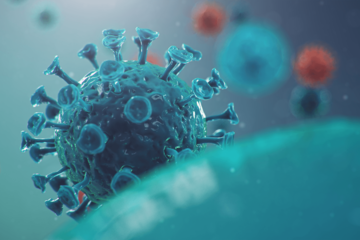We found 8 results that contain "medicine"
Posted on: #iteachmsu


Erythrocyte Sedimentation Rate
Does this test have other names?
ESR, sed rate
What is this test?
Erythrocyte sedimentation rate (ESR) is a blood test. It measures how quickly erythrocytes, or red blood cells, separate from a blood sample that has been treated so the blood will not clot. During this test, a small amount of your blood will be put in an upright tube. A lab specialist will measure the rate that your red blood cells settle toward the bottom of the tube after 1 hour.
If you have a condition that causes inflammation or cell damage, your red blood cells tend to clump together. This makes them heavier, so they settle faster. The faster your red blood cells settle and fall, the higher your ESR. A high ESR tells your healthcare provider that you may have an active disease process in your body.
Why do I need this test?
You may need this test if you have symptoms of one of the diseases that may cause ESR to go up.
You may also need this test if you have already been diagnosed with a disease that causes a high ESR. The test can allow your healthcare provider to see how well you are responding to treatment.
The ESR blood test is most useful for diagnosing or monitoring diseases that cause pain and swelling from inflammation. Other symptoms may include fever and weight loss. These diseases include:
Temporal arteritis
Rheumatoid arthritis
Polymyalgia rheumatica
ESR is not used as a screening test in people who do not have symptoms or to diagnose disease because many conditions can cause it to increase. It might also go up in many normal cases. ESR doesn't tell your healthcare provider whether you have a specific disease. It only suggests that you may have an active disease process in your body.
What other tests might I have along with this test?
You may have other tests if your healthcare provider is doing this test to diagnose a disease. One of these tests is called a C-reactive protein test, or CRP. This test also measures active inflammation in the body.
Your healthcare provider may do an ESR alone if they are monitoring a disease you already have.
Because ESR tells your healthcare provider only what is happening right now, you may need to have the test repeated over time.
What do my test results mean?
Test results may vary depending on your age, gender, health history, and other things. Your test results may be different depending on the lab used. They may not mean you have a problem. Ask your healthcare provider what your test results mean for you.
ESR is measured in millimeters per hour (mm/hr). The normal values are:
0 to 15 mm/hr in men
0 to 20 mm/hr in women
ESR above 100 mm/h is most likely caused by an active disease. For instance, you may have:
A disease that causes inflammation in your body
An active infection
Cancer
Heart disease
Kidney disease
Blood disease
Diabetes
Collagen vascular disease
How is this test done?
The test is done with a blood sample. A needle is used to draw blood from a vein in your arm or hand.
Does this test pose any risks?
Having a blood test with a needle carries some risks. These include bleeding, infection, bruising, and feeling lightheaded. When the needle pricks your arm or hand, you may feel a slight sting or pain. Afterward, the site may be sore.
What might affect my test results?
Many things that are not active diseases can increase your ESR. These include:
Pregnancy
Old age
Being female
Having a menstrual period
Having recently eaten a fatty meal
Being obese
Taking certain medicines
How do I get ready for this test?
You don't need to prepare for this test. Be sure your healthcare provider knows about all medicines, herbs, vitamins, and supplements you are taking. This includes medicines that don't need a prescription and any illegal drugs you may use. Tell your healthcare provider if you ate a fatty meal recently, if you are having your period, or if you may be pregnant.
Medical Reviewers:
Chad Haldeman-Englert MD
Raymond Turley Jr PA-C
Tara Novick BSN MSN
ESR, sed rate
What is this test?
Erythrocyte sedimentation rate (ESR) is a blood test. It measures how quickly erythrocytes, or red blood cells, separate from a blood sample that has been treated so the blood will not clot. During this test, a small amount of your blood will be put in an upright tube. A lab specialist will measure the rate that your red blood cells settle toward the bottom of the tube after 1 hour.
If you have a condition that causes inflammation or cell damage, your red blood cells tend to clump together. This makes them heavier, so they settle faster. The faster your red blood cells settle and fall, the higher your ESR. A high ESR tells your healthcare provider that you may have an active disease process in your body.
Why do I need this test?
You may need this test if you have symptoms of one of the diseases that may cause ESR to go up.
You may also need this test if you have already been diagnosed with a disease that causes a high ESR. The test can allow your healthcare provider to see how well you are responding to treatment.
The ESR blood test is most useful for diagnosing or monitoring diseases that cause pain and swelling from inflammation. Other symptoms may include fever and weight loss. These diseases include:
Temporal arteritis
Rheumatoid arthritis
Polymyalgia rheumatica
ESR is not used as a screening test in people who do not have symptoms or to diagnose disease because many conditions can cause it to increase. It might also go up in many normal cases. ESR doesn't tell your healthcare provider whether you have a specific disease. It only suggests that you may have an active disease process in your body.
What other tests might I have along with this test?
You may have other tests if your healthcare provider is doing this test to diagnose a disease. One of these tests is called a C-reactive protein test, or CRP. This test also measures active inflammation in the body.
Your healthcare provider may do an ESR alone if they are monitoring a disease you already have.
Because ESR tells your healthcare provider only what is happening right now, you may need to have the test repeated over time.
What do my test results mean?
Test results may vary depending on your age, gender, health history, and other things. Your test results may be different depending on the lab used. They may not mean you have a problem. Ask your healthcare provider what your test results mean for you.
ESR is measured in millimeters per hour (mm/hr). The normal values are:
0 to 15 mm/hr in men
0 to 20 mm/hr in women
ESR above 100 mm/h is most likely caused by an active disease. For instance, you may have:
A disease that causes inflammation in your body
An active infection
Cancer
Heart disease
Kidney disease
Blood disease
Diabetes
Collagen vascular disease
How is this test done?
The test is done with a blood sample. A needle is used to draw blood from a vein in your arm or hand.
Does this test pose any risks?
Having a blood test with a needle carries some risks. These include bleeding, infection, bruising, and feeling lightheaded. When the needle pricks your arm or hand, you may feel a slight sting or pain. Afterward, the site may be sore.
What might affect my test results?
Many things that are not active diseases can increase your ESR. These include:
Pregnancy
Old age
Being female
Having a menstrual period
Having recently eaten a fatty meal
Being obese
Taking certain medicines
How do I get ready for this test?
You don't need to prepare for this test. Be sure your healthcare provider knows about all medicines, herbs, vitamins, and supplements you are taking. This includes medicines that don't need a prescription and any illegal drugs you may use. Tell your healthcare provider if you ate a fatty meal recently, if you are having your period, or if you may be pregnant.
Medical Reviewers:
Chad Haldeman-Englert MD
Raymond Turley Jr PA-C
Tara Novick BSN MSN
Posted by: Chathuri Super admin..
Disciplinary Content
Posted on: #iteachmsu


3 Kinds of Exercise That Boost Heart Health
Aerobic Exercise
What it does: Aerobic exercise improves circulation, which results in lowered blood pressure and heart rate, Stewart says. In addition, it increases your overall aerobic fitness, as measured by a treadmill test, for example, and it helps your cardiac output (how well your heart pumps). Aerobic exercise also reduces the risk of type 2 diabetes and, if you already live with diabetes, helps you control your blood glucose.
How much: Ideally, at least 30 minutes a day, at least five days a week.
Examples: Brisk walking, running, swimming, cycling, playing tennis, and jumping rope. Heart-pumping aerobic exercise is the kind that doctors have in mind when they recommend at least 150 minutes per week of moderate activity.
Resistance Training (Strength Work)
What it does: Resistance training has a more specific effect on body composition, Stewart says. For people who are carrying a lot of body fat (including a big belly, which is a risk factor for heart disease), it can help reduce fat and create leaner muscle mass. Research shows that a combination of aerobic exercise and resistance work may help raise HDL (good) cholesterol and lower LDL (bad) cholesterol.
How much: At least two nonconsecutive days per week of resistance training is a good rule of thumb, according to the American College of Sports Medicine.
Examples: Working out with free weights (such as hand weights, dumbbells, or barbells), on weight machines, with resistance bands or through body-resistance exercises, such as push-ups, squats, and chin-ups.
Stretching, Flexibility, and Balance
What they do: Flexibility workouts, such as stretching, don’t directly contribute to heart health. What they do is benefit musculoskeletal health, which enables you to stay flexible and free from joint pain, cramping, and other muscular issues. That flexibility is a critical part of being able to maintain aerobic exercise and resistance training, says Stewart.
“If you have a good musculoskeletal foundation, that enables you to do the exercises that help your heart,” he says. As a bonus, flexibility and balance exercises help maintain stability and prevent falls, which can cause injuries that limit other kinds of exercise.
How much: Every day and before and after another exercise.
Examples: Your doctor can recommend basic stretches you can do at home, or you can find DVDs or YouTube videos to follow (though check with your doctor if you’re concerned about the intensity of the exercise). Tai chi and yoga also improve these skills, and classes are available in many communities.Testing
What it does: Aerobic exercise improves circulation, which results in lowered blood pressure and heart rate, Stewart says. In addition, it increases your overall aerobic fitness, as measured by a treadmill test, for example, and it helps your cardiac output (how well your heart pumps). Aerobic exercise also reduces the risk of type 2 diabetes and, if you already live with diabetes, helps you control your blood glucose.
How much: Ideally, at least 30 minutes a day, at least five days a week.
Examples: Brisk walking, running, swimming, cycling, playing tennis, and jumping rope. Heart-pumping aerobic exercise is the kind that doctors have in mind when they recommend at least 150 minutes per week of moderate activity.
Resistance Training (Strength Work)
What it does: Resistance training has a more specific effect on body composition, Stewart says. For people who are carrying a lot of body fat (including a big belly, which is a risk factor for heart disease), it can help reduce fat and create leaner muscle mass. Research shows that a combination of aerobic exercise and resistance work may help raise HDL (good) cholesterol and lower LDL (bad) cholesterol.
How much: At least two nonconsecutive days per week of resistance training is a good rule of thumb, according to the American College of Sports Medicine.
Examples: Working out with free weights (such as hand weights, dumbbells, or barbells), on weight machines, with resistance bands or through body-resistance exercises, such as push-ups, squats, and chin-ups.
Stretching, Flexibility, and Balance
What they do: Flexibility workouts, such as stretching, don’t directly contribute to heart health. What they do is benefit musculoskeletal health, which enables you to stay flexible and free from joint pain, cramping, and other muscular issues. That flexibility is a critical part of being able to maintain aerobic exercise and resistance training, says Stewart.
“If you have a good musculoskeletal foundation, that enables you to do the exercises that help your heart,” he says. As a bonus, flexibility and balance exercises help maintain stability and prevent falls, which can cause injuries that limit other kinds of exercise.
How much: Every day and before and after another exercise.
Examples: Your doctor can recommend basic stretches you can do at home, or you can find DVDs or YouTube videos to follow (though check with your doctor if you’re concerned about the intensity of the exercise). Tai chi and yoga also improve these skills, and classes are available in many communities.Testing
Authored by: Viju
Navigating Context
Posted on: #iteachmsu

Careers for iGen'ers - You Need Either Skills or Education: Test article
Careers for iGen'ers - You Need Either Skills or Education
If you are iGen and looking for a career, please pick a major in fields where there will be plenty of jobs and avoid fields where the jobs are limited. Unless of course you are so different and truly one of a kind like: Michael Jordan, Prince, The Beatles, Albert Einstein, Bill Gates, Elon Musk, Kim Kardashian (just kidding).
You have two choices - pick a trade or get the right college education. Low skilled jobs will continue to disappear and you can not raise a family on the income from a low skilled job. You either need skills or education.
Healthcare and high tech are the booming fields now and that will continue for decades.
Thus careers in science, engineering, software, and medicine are a good choice.
There won't be many jobs for people who major in English, history, philosophy etc. Sorry.
If you want help choosing a new career, or making those big career decisions, check out my career counseling services.
Electrical Engineering and Software Engineering look really good. As does nursing, and being a family doctor.
Civil Engineering offers very few jobs since we are not building a lot of bridges and buildings. So avoid that.
Automotive engineering is tough. Not many US jobs except in the electric car field.
Jobs that must be done in person such as plumbers, electricians, barbers, beauticians, should still be in demand, although lower paying than jobs requiring a college education. The trades are more stable than many other careers.
Sales jobs will continue to shrink. Retails sales jobs are disappearing as shopping malls close and as Amazon takes over the world. Sales people are usually just middlemen. Who needs them? Sorry... However, sales people that do business development and find new customers are a different story. But the days of being a shoe salesman in a mall store are gone.
Business development and marketing are still good fields, but will see some unexpected changes.
The auto mechanic field is going to go through interesting changes with the growth of electric vehicles and self driving vehicles. EV's have less moving parts and fewer fluids to replace, but they still need tire changes.
Taxi driver jobs and truck driver jobs will start to experience less demand as automated vehicles take over. However, as of 2018, the demand for truck drivers is booming.
As automated electric vehicles take over, the need for individuals to own a car will be reduced. It will become more simple, less expensive, and more efficient to just walk outside, call up an app, have a driver-less Uber pick you up and take you to wherever you want to go. As long as a car can show up in 5 minutes or so, that will be the way to go. Owning your own car is not efficient, nor a good investment. Cars sit around doing nothing for 98% of their existence. They take up space, they consume your money on insurance and repairs even while they are just sitting doing nothing. How this will affect jobs, careers and the workplace will be interesting, and iGen'ers will be the first to experience this.
Space flight related jobs will pick up as we focus on getting people to the moon, Mars, and space stations.
Geology jobs, especially related to finding minerals on other planets should see a rise in demand.
Virtual Reality related jobs (whatever those are?) will pick up as VR technology becomes ubiquitous. Probably creating VR experiences will be popular.
The generation after the iGen'ers will be the ones who grow up thinking virtual reality is normal.
If you are iGen and looking for a career, please pick a major in fields where there will be plenty of jobs and avoid fields where the jobs are limited. Unless of course you are so different and truly one of a kind like: Michael Jordan, Prince, The Beatles, Albert Einstein, Bill Gates, Elon Musk, Kim Kardashian (just kidding).
You have two choices - pick a trade or get the right college education. Low skilled jobs will continue to disappear and you can not raise a family on the income from a low skilled job. You either need skills or education.
Healthcare and high tech are the booming fields now and that will continue for decades.
Thus careers in science, engineering, software, and medicine are a good choice.
There won't be many jobs for people who major in English, history, philosophy etc. Sorry.
If you want help choosing a new career, or making those big career decisions, check out my career counseling services.
Electrical Engineering and Software Engineering look really good. As does nursing, and being a family doctor.
Civil Engineering offers very few jobs since we are not building a lot of bridges and buildings. So avoid that.
Automotive engineering is tough. Not many US jobs except in the electric car field.
Jobs that must be done in person such as plumbers, electricians, barbers, beauticians, should still be in demand, although lower paying than jobs requiring a college education. The trades are more stable than many other careers.
Sales jobs will continue to shrink. Retails sales jobs are disappearing as shopping malls close and as Amazon takes over the world. Sales people are usually just middlemen. Who needs them? Sorry... However, sales people that do business development and find new customers are a different story. But the days of being a shoe salesman in a mall store are gone.
Business development and marketing are still good fields, but will see some unexpected changes.
The auto mechanic field is going to go through interesting changes with the growth of electric vehicles and self driving vehicles. EV's have less moving parts and fewer fluids to replace, but they still need tire changes.
Taxi driver jobs and truck driver jobs will start to experience less demand as automated vehicles take over. However, as of 2018, the demand for truck drivers is booming.
As automated electric vehicles take over, the need for individuals to own a car will be reduced. It will become more simple, less expensive, and more efficient to just walk outside, call up an app, have a driver-less Uber pick you up and take you to wherever you want to go. As long as a car can show up in 5 minutes or so, that will be the way to go. Owning your own car is not efficient, nor a good investment. Cars sit around doing nothing for 98% of their existence. They take up space, they consume your money on insurance and repairs even while they are just sitting doing nothing. How this will affect jobs, careers and the workplace will be interesting, and iGen'ers will be the first to experience this.
Space flight related jobs will pick up as we focus on getting people to the moon, Mars, and space stations.
Geology jobs, especially related to finding minerals on other planets should see a rise in demand.
Virtual Reality related jobs (whatever those are?) will pick up as VR technology becomes ubiquitous. Probably creating VR experiences will be popular.
The generation after the iGen'ers will be the ones who grow up thinking virtual reality is normal.
Authored by: Chathuri
Pedagogical Design
Posted on: #iteachmsu


ADHD Misconceptions
https://www.sciencedaily.com/releases/2016/10/161013103134.htm
Attention-deficit hyperactivity disorder (ADHD) is a very common condition diagnosed mainly in children.
According to the Centers for Disease Control and Prevention (CDC), 6.4 million children between four and 17 years of age have been diagnosed with ADHD as of 2011.
This primer is designed to help you understand ADHD at a deeper level and combat misconceptions.
Fact: An ADHD diagnosis requires observations of numerous symptoms in multiple settings and evidence of significant impairment.
Children are inherently energetic, sometimes even rowdy. If unruly behavior is the only symptom, then it’s difficult for a professional to say that their problem is truly a mental illness.
“ADHD is a real mental disorder. There are a myriad of reasons why children are inattentive, such as anxiety or inadequate sleep, but a child with attention-deficit disorder (ADD) or ADHD does have a condition. Diagnosis will require observations of numerous symptoms in multiple settings and evidence of significant impairment.” - Joshua Cabrera, MD, clinical psychiatrist and assistant professor at the Texas A&M College of Medicine.
The main symptoms of ADHD are inattention, hyperactivity and impulsivity.
These can manifest in different ways: persistent fidgeting, being easily distracted or forgetful and difficulty waiting for a turn.
Attention-deficit hyperactivity disorder (ADHD) is a very common condition diagnosed mainly in children.
According to the Centers for Disease Control and Prevention (CDC), 6.4 million children between four and 17 years of age have been diagnosed with ADHD as of 2011.
This primer is designed to help you understand ADHD at a deeper level and combat misconceptions.
Fact: An ADHD diagnosis requires observations of numerous symptoms in multiple settings and evidence of significant impairment.
Children are inherently energetic, sometimes even rowdy. If unruly behavior is the only symptom, then it’s difficult for a professional to say that their problem is truly a mental illness.
“ADHD is a real mental disorder. There are a myriad of reasons why children are inattentive, such as anxiety or inadequate sleep, but a child with attention-deficit disorder (ADD) or ADHD does have a condition. Diagnosis will require observations of numerous symptoms in multiple settings and evidence of significant impairment.” - Joshua Cabrera, MD, clinical psychiatrist and assistant professor at the Texas A&M College of Medicine.
The main symptoms of ADHD are inattention, hyperactivity and impulsivity.
These can manifest in different ways: persistent fidgeting, being easily distracted or forgetful and difficulty waiting for a turn.
Authored by: Viju
Disciplinary Content
Posted on: #iteachmsu


Classmates are not the only potential source of social anxiety, however; the judgment of the teacher can discourage students from participating in discussion as well. Though evaluating student responses and providing feedback is a regular function performed by the teacher, these two actions can quickly shut down the development of new ideas. Fruitful discussion occurs when students are encouraged to explore their thinking rather than striving to obtain the right answer. It is best for the teacher to avoid evaluative responses
Posted by: Chathuri Hewapathirana
Disciplinary Content
Posted on: #iteachmsu


Education is the key to everything that is good in our world today. Advances in computers, information technology, math, medicine, psychology, engineering, and every other discipline would be impossible if education didn't help us build on the advances of the great minds that came before us.
In fact, it is essential that as a society that we keep learning new things. Education is not only about the past and present, but it is also the key to the future. It will help discipline our children for the intellectual challenges of the rest of the 21st century.
In fact, it is essential that as a society that we keep learning new things. Education is not only about the past and present, but it is also the key to the future. It will help discipline our children for the intellectual challenges of the rest of the 21st century.
Posted by: Rupali Jagtap
Posted on: #iteachmsu


Genetics: The scientific study of heredity. Genetics pertains to humans and all other organisms. So, for example, there is human genetics, mouse genetics, fruit fly genetics, etc.
Human genetics today comprises a number of overlapping fields, including:
Classical or formal genetics -- the study of the transmission of single genes within families and the analysis of more complex types of inheritance.
Clinical genetics -- the diagnosis, prognosis and, in some cases, the treatment of genetic diseases.
REF: https://www.medicinenet.com/genetics/definition.htm
Human genetics today comprises a number of overlapping fields, including:
Classical or formal genetics -- the study of the transmission of single genes within families and the analysis of more complex types of inheritance.
Clinical genetics -- the diagnosis, prognosis and, in some cases, the treatment of genetic diseases.
REF: https://www.medicinenet.com/genetics/definition.htm
Posted by: Chathuri Super admin..
Disciplinary Content

